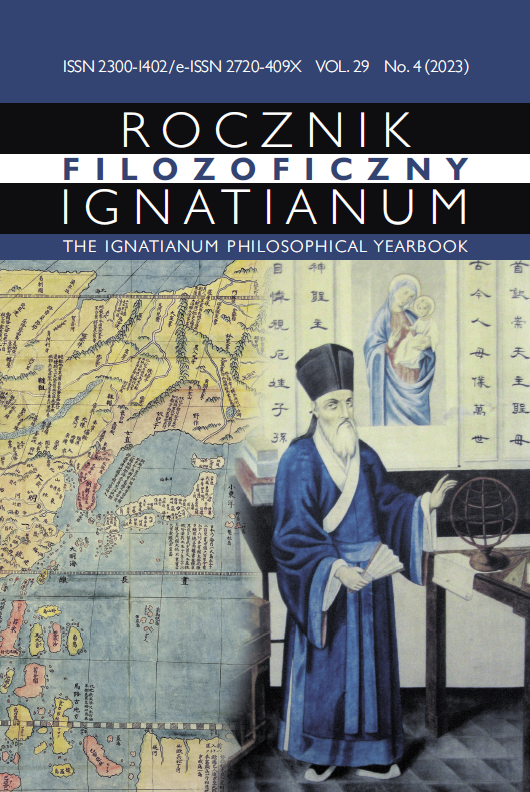An Attempt to Interpret the Meanings of a Church Rose (Rosette) Mapped with the Help of Cymatics
Abstract
We can perceive and feel sound through visual and emotional perception. Sounds shape matter. They have the ability to create geometric patterns. Using cymatics, you can visualize the shapes created by specific sound frequencies. So you can see the effects of sounds. These are patterns that are created from matter that thickens under the influence of sound vibrations. Sound is reproduced through a specific shape, through the form of a broadly understood object. Throughout the animate and inanimate world, there are patterns of repeating rhythms in which everything exists in a state of constant vibration, oscillation, and pulsation. Nikola Tesla said: “If you want to understand the Universe, start thinking in terms of energy, frequency and vibration.” The world we live in can be defined as the interaction of vibrational frequencies. Sounds create shapes (forms). The shapes of physical structures also produce sounds (vibrations), usually in the form of infrasound that is inaudible to the human ear. Such sounds have great penetration and a strong impact on inanimate and animate matter. The influence of this energy determines human behavior and determines his health. The harmonious flow of life energy is supported by shapes with gentle, rounded lines, created in accordance with the principles of Sacred Geometry. Shapes in the form of graphic signs and decorative motifs perpetuated in the traditions of many cultures have a similar effect. In architecture, you can discover relationships with figures created when sound interacts with matter. Some of these shapes are a representation of the rosette found, among others, in Christian temples. This work is an attempt to interpret the meanings of this commonly occurring shape. Any object can be a generator or amplifier of sound wave energy. The acoustic environment determines the specificity of a given space. The rosette is a specific element of architecture for many reasons. It is both a window through which color-filtered light enters the interior, it is a kind of moderator of the space of the interior acoustic environment, and it has a symbolic meaning, encoding the so far not fully understood reality of the broadly understood human environment.
References
Chladni Ernst Florens Friedrich, Die Akustik (Leipzig: Breitkopf Und Härtel, 1802).
Chladni Ernst Florens Friedrich, Entdeckungen über die theorie des Klagen (Leipzig: Weidmanns Erben und Reich, 1787).
Gibała-Kapecka Beata, Dźwięk przestrzenny – poczucie otoczenia dźwiękiem (Kraków: inAW Journal, 2020).
Gibała-Kapecka Beata, Kamisiński Tadeusz, Kapecki Tomasz, O dźwięku, akustyce i hałasie w przestrzeni miasta (Kraków: inAW Journal, 2019).
Jenny Hans, Cymatics. A Study of Wave Phenomena and Vibration, vol. 1: The Structure and Dynamics of Waves and Vibrations, 1967; vol. 2: Wave Phenomena, Vibrational Effects and Harmonic Oscillations with their Structure, Kinetics and Dynamics (1974), https://monoskop.org/images/7/78/Jenny_Hans_Cymatics_A_Study_of_Wave_Phenomena_and_Vibration.pdf (dostęp: 05.05.2023).
Makarewicz Rufin, Dźwięki i fale (Poznań: Wydawnictwo Naukowe UAM, 2004), 108.
Hyungyu Jin, Oscar D. Restrepo, Nikolas Antolin, Stephen R. Boona, Wolfgang Windl, Roberto C. Myers & Joseph P. Heremans, “Phonon-induced diamagnetic force and its effect on the lattice thermal conductivity”, Nature Mater 14 (2015): 601–606.
Jenny Hans, „Cymatics: the sculpture of vibrations”, The Unesco Courier (December 1969): 4–9.
Kostowski Edward, „Materia, energia: aktualność myśli Engelsa”, Folia Philosophica 5 (1988): 149–163.
Rasmussen Steen, „Odczuwanie architektury”, Murator (1999): 224. Słojewska Ilona, „Dialog muzyki z wodą”, Czwarty Wymiar 7 (2010): 48–49.
Pijoan Jose, „Sztuka gotycka”, w: Sztuka świata (Warszawa: Arkady, 2017), 31–65.
http://www.nutao.pl/cymatyka-cos-wiecej-niz-tylko-muzyka/ (dostęp: 18.03.2023).
http://www.nutao.pl/masaru-emoto-i-jego-eksperymenty-z-woda/ (dostęp: 15.05.2023).
https://ancientaliens.wordpress.com/2011/01/04/the-mystery-of-abydos-and-the-osirion-temple/ (dostęp: 18.04.2023).
https://docplayer.pl/203168854-Sztuka-gotyku-europejskiego-architektura.html (dostęp: 18.04.2023).
https://kierul.wordpress.com/2018/04/28/ernst-chladni-czy-mozna-zobaczyc-dzwiek-1787/ (dostęp: 13.04.2023).
https://pl.depositphotos.com/stock-photos/kilmartin.html (dostęp: 18.04.2023). https://sosreb.wordpress.com/2012/12/07/rozeta-motyw-wiecej-niz-dekoracyjny/ (dostęp: 18.04.2023). https://www.facebook.com/CymaticUniverse/photos/a.1737830546505725/3086653688290064/?type=3 (dostęp: 05.05.2023).
https://www.historiasztuki.com.pl/strony/002-00-10-STYLE-GOTYK.html (dostęp: 18.04.2023).
https://www.pbase.com/image/21634315 (dostęp: 05.05.2023). https://www.soundlovemedicine.pl/2016/11/21/z-dzwieku-powstales-w-dzwiek-sie-obrocisz/ (dostęp: 13.04.2023).
Copyright (c) 2023 Ignatianum University in Cracow

This work is licensed under a Creative Commons Attribution 4.0 International License.
The Yearbook only accepts materials for publication that are free of all conflicts of interest, and that in no way involve conflicts over authorship, copyright, etc. The Editors will take action against any cases of plagiarizing, ghostwriting1, guest/honorary authorship2, etc. Where co-authored work is concerned, the Author listed first is expected to take responsibility for the submission, and is required to make clear the contributions of all of the Co-Authors involved. In the event of the publication owing its existence to funding dedicated to this purpose, this fact should be made clear: e.g. in any note of thanks/acknowledgement, or in a footnote, etc. Explicit notification should be given of any form of reprinting, with the appropriate evidence of permission to publish being furnished as required. Any impropriety on the part of Authors/Reviewers risks exposing them to appropriate responses from the relevant institutions.
______
1 This term refers to instances of a person who has made an essential contribution being omitted from the list of authors, or from notes conveying gratitude and/or acknowledgement.
2 This occurs when a person who has made either an insignificant contribution or no contribution at all nevertheless appears on the list of authors.





